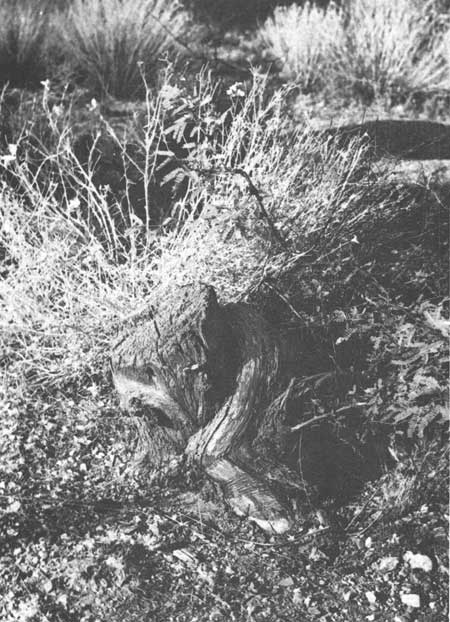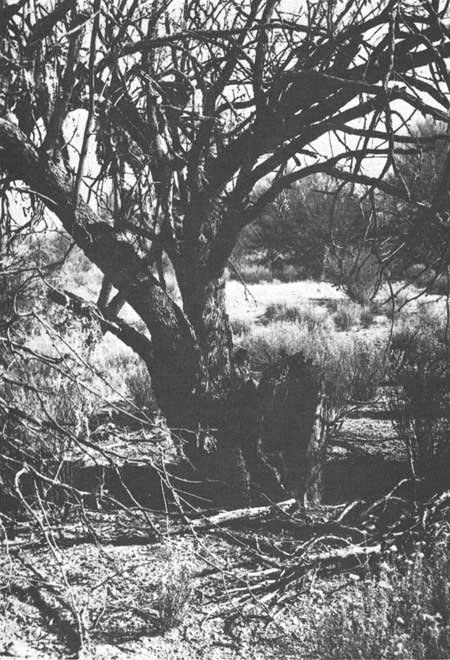|
SAGUARO
Ecology of the Saguaro: II NPS Scientific Monograph No. 8 |

|
CHAPTER 6:
OVERVIEW AND OUTLOOK
It is bootless at this time to attempt to explain the apparent decadence of the Giant Cactus. A fuller knowledge of its germination and the behavior of its seedlings, together with a more complete knowledge of the periodicity of certain climatic elements within its range will be sure to throw light on the fall in its rate of establishment.—Forrest Shreve, "The rate of establishment of the giant cactus." 1910:240.
Now that we have established the nature and operation of the factors that control germination, establishment, and survival of young saguaros in Saguaro National Monument and elsewhere in this more northerly portion of their range, it is possible to draw conclusions concerning the current status of these populations in relation to past conditions, events, and activities, and in some measure to predict their future course.
Commerce and Conservation: The
Human Factor
Coming down the northern point of the mountain and out westward into the plain, we transferred ourselves in a few hours from the temperate to the torrid zone. In the foot-slopes we passed through an ardent grove of giant cacti, called by Mexicans "Sahuaros," some of them fifty feet high. Among these prickly horrors grew a variety of lesser ones, more or less closely related to them.—Lt. John Bigelow, Jr., "After Geronimo." 1887:522.
This oldest known observation on the stands of saguaro cactus at Saguaro National Monument—1886, quoted above—contains just enough information to whet the appetite of curiosity and to stir speculation on the condition of that saguaro forest nearly 100 years ago. Unfortunately, for purposes of understanding the present condition of the saguaro populations within the monument in relation to historical uses and abuses of the land, known references are few and nonspecific.
Further, we must add that the scattered available records are in need of much additional search and evaluation to provide detail on historic activities that relate to the past and present condition of the saguaro populations. Our present knowledge of historical conditions and factors that may relate to the past and present condition of saguaro populations in Saguaro National Monument is limited largely to the information that the various noted activities did take place, and to the approximate time and location of their occurrence.
The absence of specific information, i.e., numbers, names, dates, and precise locations of historic activities within the monument, does not allow us to ignore the fact or possible significance of their occurrence. Neither does it preclude generalized evaluation of the effects of these kinds of activities on saguaro establishment and survival. It is not our intention to document here in great detail the period or extent of any of the historic activities that may have influenced the subsequent condition of saguaro populations within Saguaro National Monument. Rather, we concern ourselves with the question of the relationship of these kinds of activities to known natural factors affecting the germination, establishment, and survival of young saguaros.
Cactus pirates
During the early part of this century, large numbers of young saguaros in the Tucson vicinity were removed for sale to cactus fanciers and for landscaping purposes; the practice continues although not in the monument area. Former residents of the east monument area state that, prior to 1933, cactus merchants were active in the Cactus Forest area, and that large numbers of young plants were removed by these operators.
There is no reliable basis for estimating the number of saguaros removed during these operations. That young saguaros were present in numbers sufficient to support such operators, however, is significant. The presence at that time of these young plants leaves no question that conditions were favorable for saguaro establishment, and for their survival to a size and age suitable for "harvest." It is likely that most of the saguaros sought and removed were the easily transplantable sizes of the 10- to 30-year-old age group.
Plants of that age class have a high natural life expectancy. They have grown beyond the age of high vulnerability to the principal agents of young saguaro mortality, and are entering a long period of growth when they are least vulnerable to the climatic factors that kill large adult plants. Thus, it is not unreasonable to assume that, in the absence of human intervention, a large proportion of those plants removed by cactus merchants would be alive today as intermediate-size adult saguaros—the age-group largely missing in the Cactus Forest now and from the time the original monument was established.
Woodcutting
A portion of the east monument, mainly including the Cactus Forest area, was included within the Fort Lowell military reservation and served as a source of lime during construction of the fort. Remains of limestone kilns are still present near the northeast edge of the Cactus Forest area. The green wood of paloverde trees was used to fire the kilns. However, because of the rapidity with which the wood of this species decomposes, no stumps remain to indicate the number of paloverde trees removed for this use.
Mesquite (Prosopis juliflora), a preferred firewood species, was cut intensively within the area. The durable dead stumps of this species are abundant in the Cactus Forest area, and most of the living mesquite trees are sprouted from old stumps (Fig. 46).

|
| Fig. 46A. Stumps of mesquite (Prospis juliflora), a preferred firewood species, are abundant in the Cactus Forest at Saguaro National Monument (east). Activities of woodcutters during the early part of this century reduced the number and favorability of sites for subsequent establishment of saguaros. In addition, the removal of trees undoubtedly contributed to the destruction of established saguaros. Photographed 19 June 1968. |

|
| Fig. 46B. Mesquite trees (Prosopis juliflora) resprouted from cut stumps are common in the Cactus Forest, Saguaro National Monument (east). Young saguaros established within the last 10-15 years now occur beneath a large proportion of such resprouted mesquite trees. Photographed 20 January 1971. |
Activities of woodcutters affect the fate of young saguaros growing beneath the trees they remove. Not only are such plants liable to mechanical destruction by the woodcutters themselves, the survivors are fully exposed to trampling by cattle, and to the full decimating impact of the biotic and abiotic environment. In addition to such direct destruction of established saguaros, woodcutting also reduced the number of favorable sites for subsequent saguaro establishment. Without the modifying influence of protective plant cover, the associated microhabitats were no longer suitable for the establishment of saguaros.
| <<< Previous | <<< Contents >>> | Next >>> |
chap6.htm
Last Updated: 21-Oct-2005